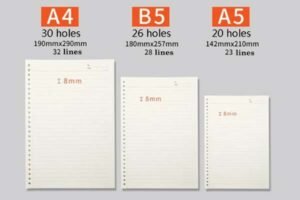
Starting a new business venture feels exciting, but risky. You might wonder if selling something seemingly simple like notebooks can actually make money, especially with so much competition out there. Yes, it definitely can be profitable, if you approach it correctly.
Yes, a notebook business1 can certainly be profitable. Success hinges on understanding your target market, offering unique customizations or features, managing production costs effectively, and building a relationship with a reliable manufacturing partner.
Profitability in the notebook world doesn't just happen by chance. It comes from smart planning and execution. You need to think about who you're selling to – students, professionals, artists, corporations? Then, how will your notebooks stand out? Maybe it's unique cover designs, special paper types, or eco-friendly materials. Controlling your costs per notebook is also crucial, and that often comes down to finding a manufacturer who offers quality at a good price point, especially as you order more.
Let's break down those factors a bit more.
- Target Audience: Selling basic notebooks to students requires a different approach than selling high-end planners to executives. Knowing your niche helps define your product and marketing.
- Differentiation: This is key. Custom covers (like hot stamping or embossing), specific paper rulings (dots, grids), unique binding (like lay-flat or ring binders), or sustainable materials can command higher prices.
- Cost Management: Your profit margin depends heavily on your production cost. Working directly with a manufacturer like us can give you better control over this.
- Manufacturer Partnership: A good partner understands your needs, offers flexibility, maintains quality, and helps you scale.
Can I make money selling notebooks?
So, we know it's possible to be profitable. But how do you, as a business owner or buyer, actually make money selling notebooks? Let's look at the practical side of turning notebooks into revenue.
You make money by ensuring your selling price is higher than your total cost per notebook. This involves smart sourcing for production, effective marketing, finding the right sales channels, and offering products that customers value enough to pay a premium for.

Making money means managing the gap between your costs and your selling price. It sounds simple, but there are many details to consider. Lowering your costs through efficient manufacturing and bulk orders is one side. The other side is increasing the perceived value so you can command a better price. This involves understanding both the production details and market demands.
Understanding Costs and Revenue
To really grasp how to make money, let's look closely at the numbers and strategies involved.
Breaking Down the Costs
Every notebook has associated costs. Understanding these helps you price correctly.
- Manufacturing: This is usually the biggest chunk. It includes:
- Materials: Paper (type, weight), cover stock, ink, binding (glue, wire, rings). Quality paper like 100gsm acid-free or specialized options cost more but add value.
- Processes: Printing, cutting, binding, cover treatments (hot stamping adds ~$0.08, laser engraving ~$0.12).
- Labor & Overheads: The factory's operational costs.
- Design & Customization: If you need unique designs or complex customizations, there might be initial setup fees or higher per-unit costs.
- Shipping & Logistics: Getting the notebooks from the factory to your warehouse or customers. Costs vary significantly based on location, speed, and volume (e.g., EXW vs. FOB vs. DDP).
- Marketing & Sales: Website costs, advertising, sales commissions, packaging for retail.
Here’s a simplified look at how volume impacts manufacturing cost (based on our typical pricing for standard notebooks):

| Quantity | Estimated Cost per Unit (USD) | Notes |
|---|---|---|
| > 1,000 units | $0.84 - $1.70 | Good starting point for smaller businesses. |
| > 10,000 units | $0.63 - $1.30 | Significant cost savings with volume. |
| Custom Add-ons | ||
| Hot Stamping | + $0.08 / unit | Adds perceived value for branding. |
| Laser Engraving | + $0.12 / unit | Unique, durable customization. |
| Paper Upgrade | + $0.07 (80gsm -> 100gsm) | Better writing experience, less bleed-through. |
Note: These are estimates. Actual costs depend on exact specifications.
Strategies for Generating Revenue
Knowing your costs is half the battle. Here’s how to ensure revenue exceeds those costs:
- Target Specific Niches: Don't try to sell to everyone. Focus on groups with specific needs:
- Corporate Gifts: Companies like James Wong's often need branded, high-quality notebooks in manageable batches (e.g., 300 sets). Offering reliable customization like laser engraving LOGOs is key.
- Educational Institutions: Schools often require bulk orders of durable, functional notebooks. Meeting specific needs like bilingual printing or subject dividers (like Sarah Müller's request) creates value.
- Retail & Specialty Stores: Unique designs, eco-friendly materials (FSC certified), or special features (like the Japanese brand's tear-out pages for washi tape) attract retail customers.
- Creative Professionals: Designers or artists might need specific paper types (sketch paper) or unique formats (bare spine binding for lay-flat use).
- Offer Value-Added Features: Go beyond the basic notebook.
- Premium Materials: Use heavier paper (100-120gsm), specialty paper (Tomoe River), durable covers (clothbound, PP plastic), or high-quality metal rings (304 stainless steel).
- Customization Options: Offer various cover processes, page formats (dot grid, planner layouts), and binding types.
- Bundling: Create sets (notebook + pen + binder) for higher perceived value.
- Sustainability: Appeal to eco-conscious consumers with FSC™ certified paper, recycled materials, soy ink, or bagasse covers. We find this is crucial for markets like Germany.
- Optimize Sales Channels: Sell where your target customers shop. This could be directly via your website, through online marketplaces, wholesale to retail stores, or directly to corporations.
- Smart Pricing: Price based on value, not just cost. If your notebook solves a specific problem (like Yuki Nakamura's need for an ultra-thin planner) or offers unique appeal, you can justify a higher price point.
The Importance of Your Manufacturing Partner
Your ability to execute these strategies often depends on your manufacturer. A good partner doesn't just make notebooks; they enable your business. Key factors include:
- Capability: Do they have the right equipment (like Heidelberg binders for quality) and processes (like various cover treatments)?
- Flexibility: Can they handle different order sizes (from 100-unit samples to 500,000+ monthly production)? Can they accommodate specific customization requests?
- Quality Control: Do they have robust QC processes (like paper testing, binding strength tests, compliance checks like REACH/SVHC) to ensure consistency?
- Reliability: Do they meet deadlines and communicate clearly? Do they understand international logistics (offering terms like FOB or DDP)?
- Expertise: Can they offer advice on materials or cost-saving alternatives?
Working with a manufacturer that has vertical integration (controlling more steps, like paper processing or metal stamping) can often lead to better quality control and potentially lower costs.
Why Partner with NotebookRing®?
Choosing the right manufacturing partner is arguably one of the most critical steps to building a profitable notebook business. After being in this industry since 2006, I've seen firsthand how crucial this relationship is.
At NotebookRing®, we've built our entire operation around being the right partner. Here's why you might consider working with us:
- Deep Experience: With 18 years focused solely on paper stationery, we understand the nuances of producing high-quality notebooks and binders.
- Full-Process Control: We run our own special paper processing and metal stamping workshops. This vertical integration means better quality oversight and cost management from raw materials to finished goods.
- Extensive Customization: Whether it's unique cover finishes (hot stamping, laser, embossing, cloth), special paper (acid-free, recycled, Tomoe River, sketch), diverse bindings (sewn, coil, ring binder systems), or specific sizes (A5, B6, passport), we can likely make it happen. We're compatible with international standards like Filofax and Campus.
- Quality You Can Trust: Our 4-level quality inspection process (paper checks, binding tests, metal corrosion tests, transport simulation) and certifications (ISO 9001, FSC™, BSCI, REACH/SVHC) ensure your products meet high standards, suitable for demanding markets in Europe, the US, Japan, and Korea.
- Flexibility for Your Needs: We support sample orders starting at 100 units and full production runs from 500 units upwards, scaling to over 500,000 notebooks monthly. We understand the needs of both startups and established brands.
- Proven Success: We've helped clients like a German bookstore chain develop FSC-certified bestsellers, a Silicon Valley tech company create cost-effective onboarding kits, and a Japanese brand launch innovative products.
- Global Logistics Support: We offer reliable delivery (standard 30-day, expedited options) and various trade terms (EXW/FOB/DDP) to simplify getting your products where they need to be.
- Commitment to Sustainability: We offer eco-friendly options (FSC paper, recycled materials, soy ink) and actively participate in environmental initiatives, like planting trees for notebooks sold.
We aim to be more than just a supplier; we want to be a partner in your success.
Ready to explore your notebook idea?
Contact me, Timothy Wei, or my team. We're happy to discuss your project.
Email: info@notebookring.com
Website: www.notebookring.com
Ask about our free physical sample book (with 20+ material samples) and get an OEM proposal within 24 hours!
Conclusion
So, is a notebook business profitable? Absolutely. Can you make money selling notebooks? Yes, definitely. Success requires understanding your market, offering differentiated products, controlling costs, and, crucially, partnering with a capable and reliable manufacturer who understands your vision.
-
Explore this resource to understand the essential elements that can lead to a profitable notebook business, including market insights and strategies. ↩





